The Dominican Republic has a population of around 9.6 million people; 73 percent of the population is of mixed race, 16 percent are Caucasian, and 11 percent are of African descent. Around 95 percent of the population is Catholic. There is freedom of faith in the country, which allows around 2 percent of the population to practice Voodoo.
A typical Dominican family has four people. Statistically, while 42 percent of the homes are run by both parents together, about 31 percent are run by single mothers, and the rest are run by relatives.
The Dominican Republic is divided into 31 provinces; 14 are in the northwestern region of the country: Dajabón, Duarte, Espaillat, Hermanas Mirabal, La Vega, María Trinidad Sánchez, Monseñor Nouel, Montecristi, Puerto Plata, Samaná, Sánchez Ramírez, Santiago, Santiago Rodríguez and Valverde.
Each province depends on the central government. Each, however, also has its own local authorities: governor, senators, deputies, mayor, etc.
Nationwide unemployment is around 15 percent. To help fight the situation, the government has created and granted a debit “Solidarity” card to more than 800,000 families across the country so they can get food for themselves and their children by using money allocated by the government every month.
Free-zone industries have closed in some towns causing unemployment to rise even higher. Unemployed parents don’t have many options; most try to find small jobs each day. The most common regular occupation in the urban areas of these provinces is that of motorcycle-taxi driver, which allows a man to make between $6 and $15 daily.
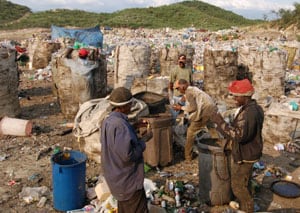 When family income is not enough, it is quite common to see children in the streets begging, cleaning windshields at crossroads, shining shoes, or selling pirated DVDs and CDs to generate income to help their families.
When family income is not enough, it is quite common to see children in the streets begging, cleaning windshields at crossroads, shining shoes, or selling pirated DVDs and CDs to generate income to help their families.
Children are also involved in scavenging in the dump, drug trafficking and child prostitution. Some of the worst cases of child labor and exploitation can be found at the Rafey garbage dump near the community of Cienfuegos in the province of Santiago. Entire families search the garbage to collect cardboard, glass, plastic and metal waste materials and anything they can sell or barter.
Given that many homes in Cienfuegos serve as warehouses for the variety of sorted waste materials brought from the dump, good hygiene is a challenge. But health consequences are dramatic and include skin diseases and other related illnesses. Even the street dogs get fungus that cause them to lose their hair.
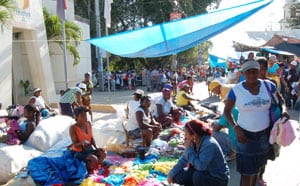 A similar form of child labor and exploitation can be found in Dajabón, a border town where unemployment is high and the children often stop attending the Compassion-assisted child development centers because the parents take them to the local Haitian-Dominican market to help carry goods. The Haitians sell items like shoes, clothes and personal care products to the Dominicans. The Dominicans sell the Haitians foods such as corn, wheat, rice, beans, chicken, eggs, spaghetti, oil, herring, vegetables and others.
A similar form of child labor and exploitation can be found in Dajabón, a border town where unemployment is high and the children often stop attending the Compassion-assisted child development centers because the parents take them to the local Haitian-Dominican market to help carry goods. The Haitians sell items like shoes, clothes and personal care products to the Dominicans. The Dominicans sell the Haitians foods such as corn, wheat, rice, beans, chicken, eggs, spaghetti, oil, herring, vegetables and others.
Families living in extreme poverty in the northwest usually have one meal a day. To help keep the children from going to bed with an empty stomach, the meal is eaten at around 5 in the afternoon. Many families use firewood to cook their meals, and the smoke will sneak through the gaps in the wooden walls and the tin-sheet roofs of homes.
Primary and high school education is generally available in the northwest, but not all students can afford it.
Thousands of families in the Northwest become homeless each year due to the tropical storms and hurricanes that hit the island of Hispaniola between May 1 and Nov. 30. Their poverty worsens when their homes are destroyed, and the small amount of money they have must be used for relocation.
Examples of child development centers located in areas like this include:
DR-125, 127, 208, 242, 251, 254, 255, 293, 294, 300, 303, 306, 307, 313, 324, 326, 337, 346, 361, 380-383, 386, 388, 404, 406, 430, 466, 459, 500-505 and 600
To help you when writing to your sponsored child, here are some commonly used phrases in the local language of the northwestern region of the country:
- Mi niño (My child – when writing to a boy). Mi niña (My child – when writing to a girl). This phrase is received very dearly because it is generally used by people who love children a lot.
- ¡Hola, campeón! (Hello, champion!). This phrase is used to speak to boys. It highlights the competitive qualities of a boy.
- ¡Hola, princesa! (Hello, princess!). This phrase is used to speak to girls. It is an encouraging phrase that links a girl to fairy tales, success and the qualities of somebody who is dearly loved.
- ¡Hola, estrella! (Hello, star!). This phrase is used to speak both to boys and girls. It pertains to the children’s talents, good school performance, etc.
Mangú Recipe
A typical dish in the northwest is mangú. This Dominican dish can be eaten at any meal, especially when having a complete breakfast. This is how it is made.
Ingredients: fresh green plantains, water, salt, onion and oil.
Remove the outer peel from the plantains with a knife and slice the plantains into chunks for faster and more thorough cooking. Place the plantain pieces in water in a deep pan that allows the water to cover the chunks. Add salt to the water to taste.
Place the pan on the stove and let the plantains boil until they soften (around 20 minutes). If you can easily pierce the plantains with a fork or knife point, they are well cooked.
Remove the plantains from the water and put them in a bowl. Mash well by using a potato masher or even the flat bottom of a bottle or cup. As you mash the plantains, you can simultaneously pour in a little cool water and you will notice how soft they become.
On the side, pour some vinegar in a bowl; slice an onion and dip into the vinegar for a short while. Also, pour a little oil in a pan and place the pan on the stove flame.
When the oil is hot, remove the onion slices from the vinegar, place them in the hot oil, and stir for several seconds, avoiding burning.
Turn off the stove and pour the onion-vinegar-oil mixture over the mashed plantains, and mash again to allow all ingredients to mix well.
Serve hot either with cheese, fried eggs, boiled eggs, scrambled eggs, fried sausage, or any other food desired.

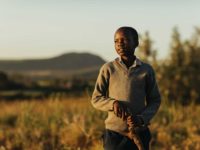

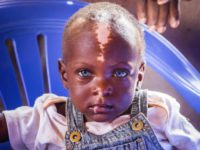
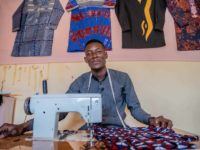


10 Comments |Add a comment
I love the idea of knowing some phrases to use in letters! Can you please do this for other countries? Thanks!
I loved reading about this area of DR. I have sponsored a young man at the 313 center for over 10 years. It’s exciting to hear about what his life might be like.
THANK YOU!!
Thank you so much for posting this. With a child in the DR, it’s wonderful to have the phrases to use in my letters that will really mean something to them! Having these phrases for all my other kids would be great, too. I hope, someday, you can provide them. :o)
Yeah, this post is really good. Could you maybe do one on a different country every week, with some background and a traditional recipe from the country? I’d like that, and I agree with what Joann wrote about Haiti too!
I can’t commit to publishing one every week, but I can commit to do more of these. I’ve already published two on Bangladesh and two on Mexico. I have more in the queue for the DR and then I’m at the mercy of the staff in the field. There will be more though. You will be able to find them all in the “what is life like” tag.
Thanks Chris! Looking forward to reading more when they come up on my page on Fb. 🙂
This type of post is so helpful! What a great idea to highlight certain areas of the country and then point out what CI projects are in that area. I especially loved seeing local phases to use when writing letters. Fabulous idea! Thanks for sharing!
Thanks for this post. I have a sponsored child from the DR- however, not this area. But I have visited the NW part of the DR- specifically Dajabon- the boarder of Haiti. I also really enjoyed the translation!
Thanks for sharing this information about the DR. It’s interesting to learn about the different countries that Compassion partners with. I’ve learned a lot through OC, but would love someone do a blog on Haiti to give us Haitian sponsors some more insight about the country. Thanks and blessings to all
LOVED this post. Our sponsored child is in the DR but not specifically in this area, and this information is so helpful. Thanks!